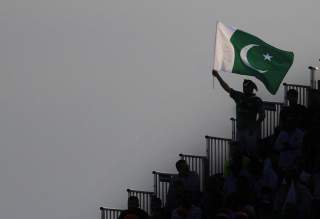Pakistan Embraces Multipolarity—and That Might Be Good for America
Pakistan’s move toward diversification in a post–American world order is reflected in its military hardware acquisitions and in its diplomatic ties.
The recent past is not encouraging. In July 2015, Pakistan hosted talks between the Afghan Taliban and Kabul government through a quadrilateral framework that included Chinese and U.S. observers. By the end of the month, Afghan officials revealed that Mullah Omar was dead, derailing the process. Still, in February 2016, Afghan and American officials were able to meet the Taliban once again in Qatar. But in May of that year, the United States killed Mullah Omar’s successor, Mullah Akhtar Mansour, who had consented to both rounds of talks.
Another cause for concern: there is no senior-level ownership of the Taliban talks within the Trump administration. The process is run by a mid-level State Department official who is unable to meet anyone above Pakistan’s foreign secretary. It’s unclear whether she speak on behalf of the U.S. president or if he even knows her name.
As a form of chastisement, the Trump administration has relegated its engagement with Islamabad to mid-level personnel, largely denying Pakistani officials access to senior U.S. officials. Though military-to-military dialogue seems to be improving, there is no way for Islamabad to ascertain whether the U.S. government as a whole is on board with dialogue with the Taliban or whether the specter of talks is simply being used a means to gain tactical advantages in the war and prolong it.
The Pakistani position on Afghanistan today is not the same as it was in 1997 or even 2007. For roughly a decade, Pakistan has deployed almost two hundred thousand troops to its Western front, actively combatting jihadist insurgents. Thousands of Pakistanis security personnel have sacrificed their lives in this long war.
Pakistan doesn’t want to fight another jihadist insurgency on its soil. It is looking for ways to either insulate itself from the mess in Afghanistan or contribute to a sustainable resolution to its neighbor’s forty-year war. Pakistan’s desired end state involves not a Taliban-dominated Afghanistan, but the inclusion of the insurgent network into a political framework that does not allow Afghanistan to be a home to anti-Pakistan militancy. This is reasonable and attainable, and actually dates back to Gen. Ashfaq Kayani’s tenure as army chief, when Pakistan first embraced the doctrine of counterinsurgency, gave up the notion of a Taliban-dominated Afghanistan, and came to terms with the U.S. presence as a temporary stabilizing force.
However, a political settlement in Afghanistan is contingent upon demonstrated U.S. ownership of a nominally Afghan-led process and a successful political transition in Kabul over the course of the next year. Pakistan has helped and can continue to help with the former. But achieving the latter is all on America and Ghani. And the indications so far are far from good.
America and Pakistan, Beyond Afghanistan
Multipolarity—and, specifically, Pakistan’s finesse in leveraging multipolarity in its own favor—may actually help U.S.-Pakistan ties in a number of ways.
One, it could give space for both countries to set realistic expectations for bilateral relations, based on clearly articulated goals.
Two, it should remind American policymakers with limited or no historical memory that Pakistan is not simply an extension of Afghanistan—it’s an able regional diplomatic and military power that has defeated a jihadist insurgency and could serve as a potential partner in an unstable greater Middle East. And despite growing macroeconomic risk, the Pakistani economy is home to a growing middle class and a potential market for American investors in the consumer goods, energy, materials, real estate and retail sectors.
Three, it allows Pakistan to fully explore the limits of other relationships and revisit the value of the United States. America has afforded Pakistani immigrants—including my own family—a combination of civic agency, religious freedom, and upward mobility unattainable in most places. It’s hard to see a replication of the Pakistani American diaspora—a prosperous community of 500,000 with a median income of $66,000—in countries like China. While the China-Pakistan relationship will continue to grow economically and strategically, it will lack this social dimension for the foreseeable future.
Unfortunately, Washington seems stuck on pursuing behavioral modification through tweets and nonlethal punitive actions directed at Islamabad and Rawalpindi. One hopes that saner minds keep the relationship in a holding pattern, allowing for a gradual takeoff if and once the Afghanistan imbroglio stabilizes.
Arif Rafiq (@arifcrafiq) is president of Vizier Consulting, LLC, which provides political risk analysis on the Middle East and South Asia. He is also a nonresident fellow at the Middle East Institute.
Image: A Pakistan fan waves their flag. Reuters / Lee Smith

